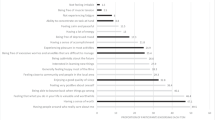Abstract
Qualitative in-person interviews with 114 olderAfrican Americans and whites with chronic illness wereconducted to assess whether they thought of themselvesas healthy or not healthy and the meanings associatedwith that assessment. The first and most frequentlyassigned attribute of healthy was the presence offunctional capacities; for not healthy it was thepresence of medical conditions or physical symptoms. While both African Americans and whites respondedsimilarly regarding the assessment of whether theywere healthy or not healthy, African Americansdescribed the attributes associated with healthy ornot healthy somewhat differently than whites. Also,both groups reported more varied meanings to theconcept of `healthy' than to `not healthy', suggestingthat `healthy' may be a multidimensional constructmore connected to ones' total life experiences than is`not healthy'. This study concludes that social andcultural factors such as race, ethnicity or healthexperiences may influence how individuals perceive anddescribe their health status and the processes used inmaking these assessments.
Similar content being viewed by others
References
Angel, R. & Thoits, P. (1987). The impact of culture on the cognitive structure of illness, Culture, Medicine and Psychiatry 11: 465-494.
Blake, J. H. (1984). 'Doctor can't do me no good': Social concomitants of health care attitudesand practices among elderly blacks in isolated rural populations. In W. H. Watson (ed.), Black Folk Medicine. New Jersey: Transaction Books.
Blaxter, M. (1990). Health and Lifestyles. New York: Travistock, Routledge.
Borawski, E. A., Kinney, J. M. & Kahana, E. (1996). Journal of Gerontology: Social Sciences 51B(3): S157-S170.
Chrisman, N. J. & Kleinman, A. (1983). Popular health care, social networks, and cultural meanings: The orientation of medical anthropology. In David Mechanic (ed.), Handbook of Health, Health Care and the Health Professions. New York: The Free Press.
Dressler, W. W. (1993). Health in the African American community: Accounting for health inequalities, Medical Anthropology Quarterly 7(4): 325-345.
Hansell, S. & Mechanic, D. (1991). Body awareness and self-assessed health among older adults, Journal of Aging and Health 14: 473-492.
Hooker, K & Siegler I.C. (1992). Separating apples from oranges in health ratings: Perceivedhealth includes psychological well-being, Behavior, Health, and Aging 2(2): 81-92.
Idler, E. L. (1999). Self-assessments of health: the next stage of studies, Research on Aging 21(3): 387-391.
Idler, E. L., Hudson, S. V. & Leventhal, H. (1999). The meanings of self-ratings of health: A qualitative and quantitative approach, Research on Aging 21(3): 458-475.
Krause, N. M. & Jay, G. M. (1994). What do global self-rated health items measure?, MedicalCare 32(9): 930-942.
McHorney, C. A., Raczek, A. E. & Ware, J. E. (1993). The MOS 36-item short form health status survey (SF-36), II: Psychometric and clinical tests of validity in measuring physical and mental health constructs, Medical Care 31: 247-263.
Patrick, D. L., Sittampalam, Y., Sommerville, S. M., Carter, W. B. & Bergner, M. (1985). A cross-cultural comparison of health status values, American Journal of Public Health 75(12): 1402-1407.
Research on Aging (1999). Special Issue: Self-assessments of health: The next stage of studies. Guest Editor, Ellen L. Idler, 21(3). Sage: Thousand Oaks.
Schulman, K. A., Berlin, J. A., Harless, W., Kerner, J. F., Sistrunk, S., Gersh, B. J., Dube, R., Taleghani, C. K., Burke, J. E., Williams, S., Eisenberg, J. M. & Escarce, J. J. (1999). The effect of race and sex on physicians' recommendations for cardiac catheterization, The New England Journal of Medicine 340(8): 618-626.
Strain, L. A. (1993). Good health: What does it mean in later life?, Journal of Aging and Health 5: 338-364.
Strawbridge, W. J. & Wallhagen, M. I. (1999). Self-rated health and mortality over three decades: Results from a time-dependent covariate analysis, Research on Aging 21(3): 402-415.
Van Doorn, C. (1999). A qualitative approach to studying, Research on Aging 21(3): 440-457.
Ware, N. C. & Kleinman, A. (1992). Culture and somatic experience: The social course of illness in neurasthenia and chronic fatigue syndrome, Psychosomatic Medicine 54: 546-560.
Ware, J. E. & Sherbourne, C.D. (1992). The MOS 36-item short-form health survey (SF-36): I: Conceptual framework and item selection, Medical Care 30(6): 473-483.
Zborowski, M. (1952). Cultural components in responses to pain. Journal of Social Issues 8: 16-30.
Zola, I. R. (1973). Pathways to the doctor-from person to patient, Social Science and Medicine 7: 677-689.
Rights and permissions
About this article
Cite this article
Silverman, M., Smola, S. & Musa, D. The meaning of healthy and not healthy: Older African Americans and whites with chronic illness. Journal of Cross-Cultural Gerontology 15, 139–156 (2000). https://doi.org/10.1023/A:1006794215571
Issue Date:
DOI: https://doi.org/10.1023/A:1006794215571




